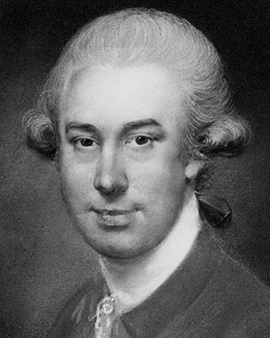John Russel, a British rococo painter, came from a wealthy family. His father worked as a book and art dealer. John's first impressions of this literary and artistic environment fell on fertile ground. In addition, John's father drew in his free time out of hobby and inspired the son with it. Russell received painting lessons as a child and later attended the art school of the Royal Academy. In 1770 one of his portrait drawings was awarded the gold medal. John Russel was a deeply religious man who regularly wrote down his feelings and fears in diaries.
Russell was mainly active as a portrait painter, who was in great demand during the French Rococo period. This style is characterized by its delicate and lively forms. This is reflected in Russell's works, which radiate a cheerful, worldly mood. He mainly used oil colours and pastel chalk, which gave his paintings a special atmosphere. His clients for the portraits attached great importance to an advantageous, unmistakable representation. Very good results could be achieved with pastel chalk.
Russell painted many still lifes, but preferably very sensitive portraits of couples, mothers with children and individuals. These pictures often show the portrayed persons in a setting that suits them and in those days they were well paid by the wealthy citizens. The British painter also created several lovingly painted pictures of girls in rural areas, for example with flowers, with cherries, a basket with eggs. Russell was able to exhibit his works throughout his life at the "Society of Artists of Great Britain". A very great honour for the British artist was his appointment as court painter in 1789 and this rank secured him numerous further commissions. Russell summarized his extensive experience with the various drawing and painting techniques in individual publications.
The British painter enthusiastically worked as an amateur astronomer and in 1794 he made, among other things, a scientific drawing for "The Map of the Moon". Another impressive study by Russell is "The Face of the Moon" from 1797, on which he worked for several years. His close friendship with the German-British astronomer William Herschel (1738-1822) had a positive effect on his work. Herschel had discovered the planet Uranus and constructed reflecting telescopes. Russell made a portrait of "Sir William Herschel", which shows him as an important scientist.
John Russell died far too early of typhus and left behind a remarkable work that was characteristic of the rococo period and is exhibited worldwide.
×





.jpg)
.jpg)
.jpg)
.jpg)
_-_(MeisterDrucke-1133254).jpg)
_-_(MeisterDrucke-1133254).jpg)
_Sun_061x042_m_Paris_Musee_-_(MeisterDrucke-1030393).jpg)
_Sun_061x042_m_Paris_Musee_-_(MeisterDrucke-1030393).jpg)
.jpg)
.jpg)
.jpg)
.jpg)
.jpg)
.jpg)
 - (MeisterDrucke-249430).jpg)
 - (MeisterDrucke-249430).jpg)
.jpg)
.jpg)
 1788 (pastel on grey paper) - (MeisterDrucke-70254).jpg)
 1788 (pastel on grey paper) - (MeisterDrucke-70254).jpg)
 - (MeisterDrucke-268233).jpg)
 - (MeisterDrucke-268233).jpg)
_-_(MeisterDrucke-1517219).jpg)
_-_(MeisterDrucke-1517219).jpg)
.jpg)
.jpg)
.jpg)
.jpg)
_-_(MeisterDrucke-35501).jpg)
_-_(MeisterDrucke-35501).jpg)
.jpg)
.jpg)
.jpg)
.jpg)
_-_(MeisterDrucke-1511338).jpg)
_-_(MeisterDrucke-1511338).jpg)
.jpg)
.jpg)
 - (MeisterDrucke-297952).jpg)
 - (MeisterDrucke-297952).jpg)
.jpg)
.jpg)
.jpg)
.jpg)
.jpg)
.jpg)
 - (MeisterDrucke-189982).jpg)
 - (MeisterDrucke-189982).jpg)
.jpg)
.jpg)
.jpg)
.jpg)
_(see_237871_for_pair)_-_(MeisterDrucke-1130133).jpg)
_(see_237871_for_pair)_-_(MeisterDrucke-1130133).jpg)
.jpg)
.jpg)
.jpg)
.jpg)
.jpg)
.jpg)
.jpg)
.jpg)
.jpg)
.jpg)
_-_(MeisterDrucke-586762).jpg)
_-_(MeisterDrucke-586762).jpg)
.jpg)
.jpg)
 - (MeisterDrucke-189348).jpg)
 - (MeisterDrucke-189348).jpg)
.jpg)
.jpg)
.jpg)
.jpg)
 - (MeisterDrucke-102446).jpg)
 - (MeisterDrucke-102446).jpg)
.jpg)
.jpg)
.jpg)
.jpg)
.jpg)
.jpg)
.jpg)
.jpg)
.jpg)
.jpg)
.jpg)
.jpg)
.jpg)
.jpg)
_-_(MeisterDrucke-1130136).jpg)
_-_(MeisterDrucke-1130136).jpg)
.jpg)
.jpg)
.jpg)
.jpg)
.jpg)
.jpg)
.jpg)
.jpg)
.jpg)
.jpg)
.jpg)
.jpg)
.jpg)
.jpg)
_-_(MeisterDrucke-295474).jpg)
_-_(MeisterDrucke-295474).jpg)
 - (MeisterDrucke-245036).jpg)
 - (MeisterDrucke-245036).jpg)
_-_(MeisterDrucke-1108390).jpg)
_-_(MeisterDrucke-1108390).jpg)
_-_(MeisterDrucke-1130134).jpg)
_-_(MeisterDrucke-1130134).jpg)
.jpg)
.jpg)
_-_(MeisterDrucke-1520077).jpg)
_-_(MeisterDrucke-1520077).jpg)
.jpg)
.jpg)
.jpg)
.jpg)
.jpg)
.jpg)
_-_(MeisterDrucke-1505781).jpg)
_-_(MeisterDrucke-1505781).jpg)
.jpg)
.jpg)
.jpg)
.jpg)
.jpg)
.jpg)
 - (MeisterDrucke-160425).jpg)
 - (MeisterDrucke-160425).jpg)
.jpg)
.jpg)
.jpg)
.jpg)
_-_(MeisterDrucke-1498592).jpg)
_-_(MeisterDrucke-1498592).jpg)
_(pastel)_-_(MeisterDrucke-1127309).jpg)
_(pastel)_-_(MeisterDrucke-1127309).jpg)
_(pastel)_-_(MeisterDrucke-1132428).jpg)
_(pastel)_-_(MeisterDrucke-1132428).jpg)
_(photogravure)_-_(MeisterDrucke-1509136).jpg)
_(photogravure)_-_(MeisterDrucke-1509136).jpg)
.jpg)
.jpg)
 1799 (pastel on paper) - (MeisterDrucke-88779).jpg)
 1799 (pastel on paper) - (MeisterDrucke-88779).jpg)
.jpg)
.jpg)
_-_(MeisterDrucke-1132426).jpg)
_-_(MeisterDrucke-1132426).jpg)
_c1795_(oil_on_panel)_-_(MeisterDrucke-1500469).jpg)
_c1795_(oil_on_panel)_-_(MeisterDrucke-1500469).jpg)
_-_(MeisterDrucke-1127154).jpg)
_-_(MeisterDrucke-1127154).jpg)
.jpg)
.jpg)
 - (MeisterDrucke-289696).jpg)
 - (MeisterDrucke-289696).jpg)
.jpg)
.jpg)
.jpg)
.jpg)
.jpg)
.jpg)
.jpg)
.jpg)
.jpg)
.jpg)
.jpg)
.jpg)
.jpg)
.jpg)
_-_(MeisterDrucke-1128683).jpg)
_-_(MeisterDrucke-1128683).jpg)
.jpg)
.jpg)
.jpg)
.jpg)
.jpg)
.jpg)
_c1776_(chalk_on_paper)_-_(MeisterDrucke-1506470).jpg)
_c1776_(chalk_on_paper)_-_(MeisterDrucke-1506470).jpg)
.jpg)
.jpg)
.jpg)
.jpg)
 - (MeisterDrucke-258711).jpg)
 - (MeisterDrucke-258711).jpg)
.jpg)
.jpg)
.jpg)
.jpg)
_-_(MeisterDrucke-1461605).jpg)
_-_(MeisterDrucke-1461605).jpg)
.jpg)
.jpg)






